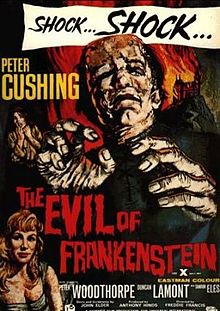The Evil of Frankenstein, an installment in the Hammer Studios Series, came to the film screen in The United States on May 8th, 1964. The film was directed by Freddie Francis. Screenplay was written by Anthony Hinds.

Movie poster for The Evil of Frankenstein (1964) http://en.wikipedia.org/wiki/The_Evil_of_Frankenstein
Synopsis[]
The Evil of Frankenstein begins with Frankenstein and his assistant Hans getting ran out of town. They pass through a carnavalesque village as the both of them head towards Baron Frankenstein's estate, which previously endured abandonment. Frankenstein and Hans encounter Frankenstein's old creature, frozen in a glacier.
Major Themes[]
Discovery[]
Discovery plays an important role in The Evil of Frankenstein. The Baron discovers upon passing through the village carnival that the Burgomaster stole his possessions for himself. Frankenstein discovers his creation from within a cave, seemingly waiting for his return. The creature, after getting shot in the head according to Frankenstein's framed narrative, fell into a glacier that kept him perfectly preserved within the cave. This scene seems rather allegorical. Frankenstein, with the help of Zoltan, discovers a new practice of bringing consciousness back into his creature's mind. Discovery seems to maintain a sort of relevance to the creature as well. In Frankenstein's framed narrative, he recalls animating the creature and the creature attempting to reach for the flame. Flames or fire tend to represent discovery or knowledge. For the creature, the fear of knowledge, and for Frankenstein, the misuse and perversion of knowledge, engulf them both in the same at the end of the story. Another instance of fire in the film occurs when Frankenstein tries to take back control of his creature. When Zoltan commands the creature to kill Frankenstein, the Baron acts fast and uses fire and fear to turn the creature on Zoltan.
Carnivalesque[]
Another obvious theme of this adaptation is the carnivalesque. The Baron and Hans speak of a carnival of festivities. The film trope points towards a state of confusion or fantasy. When peering in from afar, Frankenstein realizes that they can move safely through this area, undetected and at first this seem to be the case. Upon returning to the carnival, the Baron and his sidekick wear masks to disguise themselves. They note that while in the carnival, the people of the carnival act boisterous or erroneous; they seem out of normal character. The Burgomaster serves as an example of this, as well as his sidekick the police chief. The Burgomaster, or master of the town, stole all of Frankenstein's possessions whenever the Baron was initially exiled, living in a state of carnivalesque, one could argue, as evidenced in how he acts wrongly and overindulges. The police chief, in a way represents this too, though little footage pertains to the police chief in the film. Another character of the carnival, Zoltan, maintains the attributes of the carnival within him. His deal with Frankenstein turns into a ploy for power over Frankenstein's domain, a place where science should rule over fantasy. The caveat to his agreement with Frankenstein to return consciousness to the creature appears based on the truth that only he can truly control the creature. He commands the creature to kill and steal for his well-being. This backfires when Frankenstein controls the creature with fear, the fear of fire, or knowledge. It appears understood that aspects of the carnivalesque or of strangeness present an interesting change within the story and among its characters.
Reception[]
According to Rotten Tomatoes, The Evil of Frankenstein obtained a rating of 50 percent among critics with the consideration that the film seems rotten. The audience score for this film sets the rating at around 37 percent. Tim Brayton of Antagony and Ecstasy concluded with a rotten rating, "It's pretty wan and spotty, in fact, though probably not as bad as the most rabid Hammer fanatics would have you believe. Certainly, it is a stunningly terrible sequel." Dennis Schwarts of Ozus' World Movie Reviews mentioned with a rotten rating, "It's only the solid professional acting ability of Peter Cushing as Baron Frankenstein that gives this pic any credibility." Ken Hanke of Mountain Xpress gave the film a fresh rating, "Livelier than the usual Hammer flick."
Significance of Adaptation[]
This adaptation of the Frankenstein narrative falls into place as the third part of the Frankenstein Hammer film productions series. Peter Cushing plays the roll of Baron Frankenstein. Freddie Francis directed this portion of the series, whereas the only other directors involved in this series include Jimmy Sangster, who worked on The Horror of Frankenstein, an arguable remake of The Curse of Frankenstein. Terrence Fisher directed the rest of the Frankenstein films in this series. One of the most notable and obvious aspect of The Evil of Frankenstein when compared to the other films in this series is creature. Kiwi Kingston plays the roll of the creature in this film. The creature of this film is huge and green, has a blockhead, a loving soul for the beggar girl and an almost innate ability to put a few beers back.
References[]
"The Evil of Frankenstein." Imdb. Imdb.com. Web. 1 May. 2015. <http://www.imdb.com/title/tt0058073/>
"The Evil of Frankenstein." Rotten Tomatoes. Rottentomatoes.com. Web. 1 May. 2015.<http://www.rottentomatoes.com/m/evil_of_frankenstein/>
